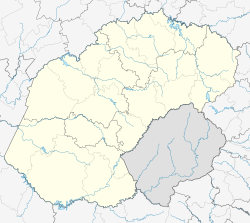
The Second Boer War, also known as the Boer War, the Anglo–Boer War, or the South African War, was a conflict fought between the British Empire and the two Boer Republics over the Empire's influence in Southern Africa from 1899 to 1902. Following the discovery of gold deposits in the Boer republics, there was a large influx of "foreigners", mostly British from the Cape Colony. They were not permitted to have a vote, and were regarded as "unwelcome visitors", invaders, and they protested to the British authorities in the Cape. Negotiations failed and, in the opening stages of the war, the Boers launched successful attacks against British outposts before being pushed back by imperial reinforcements. Though the British swiftly occupied the Boer republics, numerous Boers refused to accept defeat and engaged in guerrilla warfare. Eventually, British scorched earth policies, and the poor conditions suffered in concentration camps by Boer women and children who had been displaced by these policies, brought the remaining Boer guerillas to the negotiating table, ending the war.

De Beers Group is an international corporation that specializes in diamond mining, diamond exploration, diamond retail, diamond trading and industrial diamond manufacturing sectors. The company is active in open-pit, large-scale alluvial and coastal mining. It operates in 35 countries and mining takes place in Botswana, Namibia, South Africa, Canada and Australia.

Kimberley is the capital and largest city of the Northern Cape province of South Africa. It is located approximately 110 km east of the confluence of the Vaal and Orange Rivers. The city has considerable historical significance due to its diamond mining past and the siege during the Second Anglo-Boer war. British businessmen Cecil Rhodes and Barney Barnato made their fortunes in Kimberley, and Rhodes established the De Beers diamond company in the early days of the mining town.

Vereeniging is a town located in the south of Gauteng province, South Africa, situated where the Klip River empties into the northern loop of the Vaal River. It is also one of the constituent parts of the Vaal Triangle region and was formerly situated in the Transvaal province. The name Vereeniging is derived from the Dutch word meaning "association".
Harrismith is a large town in the Free State province of South Africa. It was named for Sir Harry Smith, a 19th-century British governor and high commissioner of the Cape Colony. It is situated by the Wilge River, alongside the N3 highway, about midway between Johannesburg, about 300 km to the north-west, and Durban to the southeast. The town is located at the junction of the N5 highway, which continues westward towards the provincial capital Bloemfontein, some 340 km to the south-west. This important crossroads in South Africa's land trade routes is surrounded by mesas and buttes. It is located at the base of one of these called Platberg.
Jacobsdal is a small farming town in the Free State province of South Africa with various crops under irrigation, such as grapes, potatoes, lucerne, and groundnuts. The town was layout in 1859 by Christoffel Jacobs on his farm Kalkfontein, and today houses 3,504 inhabitants.
Jagersfontein is a small town in the Free State province of South Africa.

Springfontein is a small mixed farming town in the Free State province of South Africa.

Breyten is a small farming town in Mpumalanga, South Africa. It is situated at the foot of Klipstapel, the highest point on the watershed between the westward-flowing Vaal River system and the eastward-flowing Olifants and Komati River systems. The town is located 25 km (15 mi) west of Chrissiesmeer, 30 km (19 mi) north of Ermelo, 32 km (20 mi) southwest of Carolina, and 35 km (21 mi) southeast of Hendrina. The main spoken languages are Zulu, Swati and Afrikaans.
Wakkerstroom,, is the second oldest town in Mpumalanga province, South Africa. The town is on the KwaZulu-Natal border, 27 km east of Volksrust and 56 km south-east of Amersfoort.
Lichtenburg is a town situated in North West Province, South Africa. It is the administrative centre of Ditsobotla Local Municipality.

Wolmaransstad is a maize-farming town situated on the N12 between Johannesburg and Kimberley in North West Province of South Africa. The town lies in an important alluvial diamond-mining area and it is the main town of the Maquassi Hills Local Municipality.

The Kimberley Mine or Tim Kuilmine is an open-pit and underground mine in Kimberley, South Africa, and claimed to be the deepest hole excavated by hand, although this claim is disputed.

Springbok is the largest town in the Namaqualand area in the Northern Cape province of South Africa. It was called Springbokfontein until 1911, when it was shortened to Springbok. Springbok is located on the N7 national route which connects the Cape with Namibia, and at the western end of the N14, which connects it with Upington and Pretoria. It is the main town of the Nama Khoi Local Municipality, which also includes a number of surrounding towns such as Okiep and Nababeep.

The Mineral Revolution is a term used by historians to refer to the rapid industrialisation and economic changes which occurred in South Africa from the 1860s onwards. The Mineral Revolution was largely driven by the need to create a permanent workforce to work in the mining industry, and saw South Africa transformed from a patchwork of agrarian states to a unified, industrial nation. In political terms, the Mineral Revolution had a significant impact on diplomacy and military affairs. Finally, the policies and events of the Mineral Revolution had an increasingly negative impact on race relations in South Africa, and formed the basis of the apartheid system, which dominated South African society for a century. The Mineral Revolution was caused by the discovery of diamonds in Kimberly in 1867 and also by the discovery of gold in Witwatersrand in 1886. The mineral mining revolution laid the foundations of racial segregation and the control of white South Africans over black South Africans. The Mineral Revolution changed South Africa from being an agricultural society to becoming the largest gold producing country in the world.

Koffiefontein Mine is a diamond mine situated in the Free State province, about 80 km from Kimberley, South Africa. It is one of the many Kimberley mines of which Kimberley mine, de Beers mine, Dutoitspan, Bultfontein and Wesselton are its more famous neighbours.

The siege of Kimberley took place during the Second Boer War at Kimberley, Cape Colony, when Boer forces from the Orange Free State and the Transvaal besieged the diamond mining town. The Boers moved quickly to try to capture the area when war broke out between the British and the two Boer republics in October 1899. The town was ill-prepared, but the defenders organised an energetic and effective improvised defence that was able to prevent it from being taken.

Petra Diamonds Ltd is a diamond mining group headquartered in Jersey. Petra own one of the world's most productive mines historically, the Cullinan Diamond Mine is famed for having produced the world's largest rough and polished diamond. The company is listed on the London Stock Exchange.

Long Cecil is a cannon built in the workshops of the De Beers mining company in Kimberley for use by the British in the Siege of Kimberley during the Second Boer War.

Daniëlskuil is a town in ZF Mgcawu District Municipality in the Northern Cape province of South Africa.


















